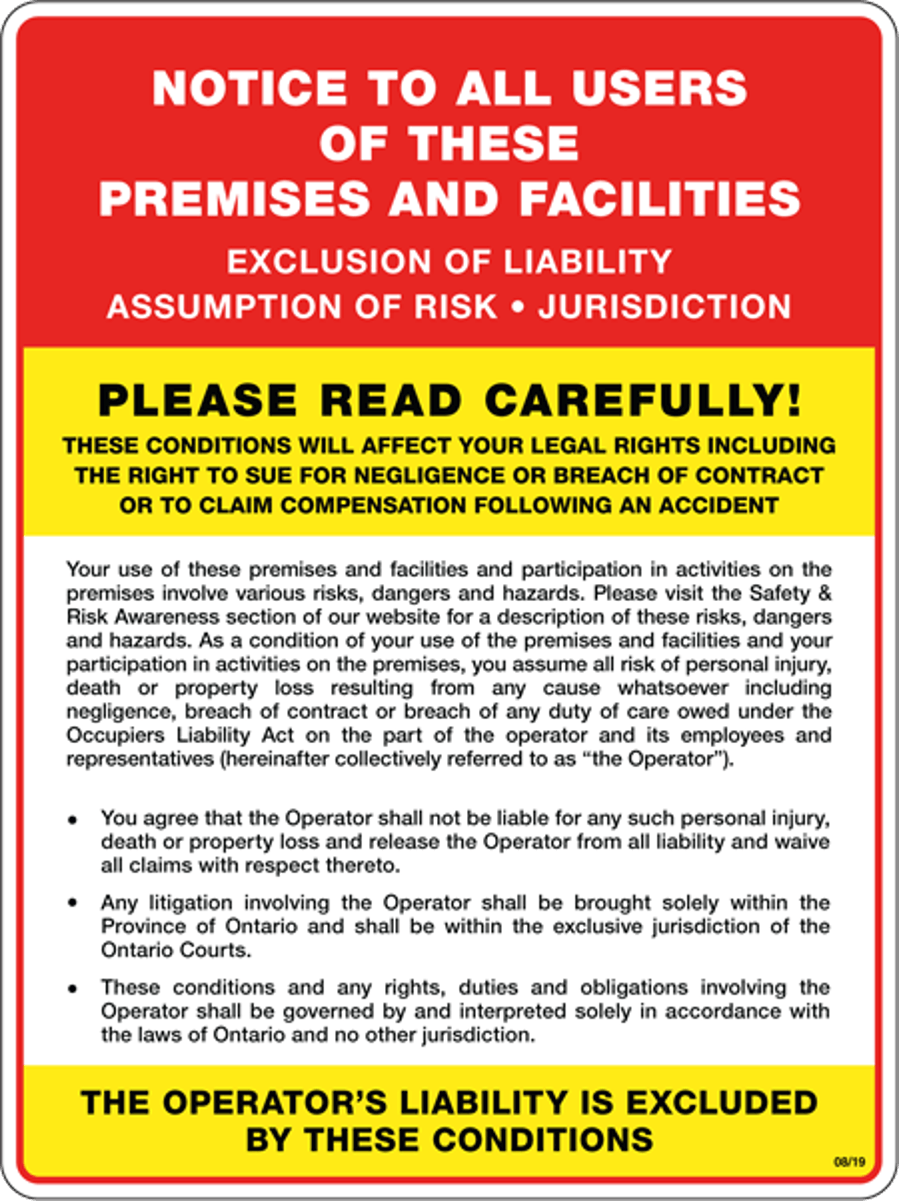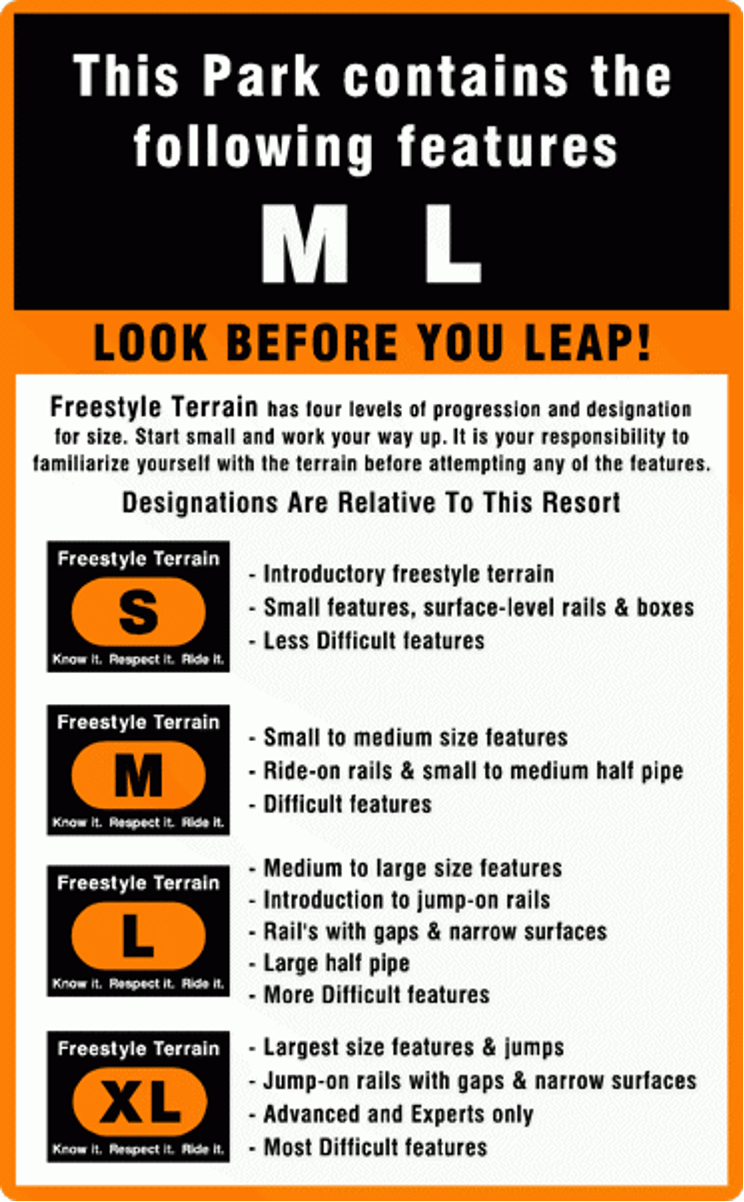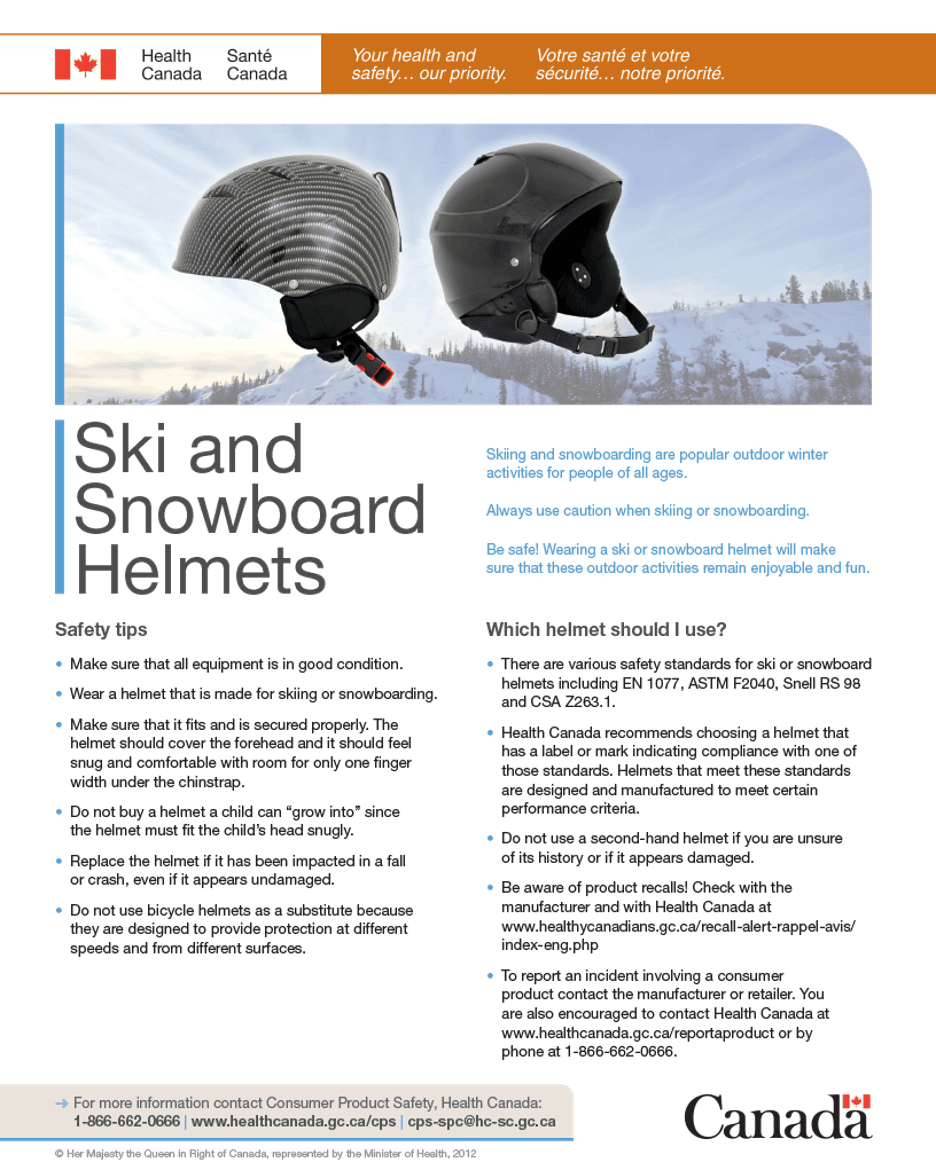Skiing, snowboarding and other activities that take place at ski areas involve the risk of injury. The information contained in the Safety and Risk Awareness section of this website is intended to inform you of the risks, dangers, and hazards that you may encounter at a ski area and help you to stay safe while enjoying these activities. Whether you are a participant in these activities or a parent or guardian of a minor participant, please take the time to familiarize yourself with the Safety and Risk Awareness information on this website.
Exclusion of Liability
The use of ski area premises and facilities and participation in activities at ski areas involves various risks, dangers, and hazards. It is a condition of your use of the premises and facilities and your participation in these activities that you assume all risk of personal injury, death or property loss resulting from any cause whatsoever, including negligence, breach of contract, or breach of any duty of care on the part of the ski area operator. Your legal responsibility as a user of the ski area premises and facilities or participant in activities at the ski area is explained in the following notice, which you will see posted at the ski area.
Skiing and Snowboarding
Skiing and snowboarding involve various risks, dangers and hazards including, but not limited to the following:
- boarding, riding and disembarking ski lifts;
- changing weather conditions;
- avalanches;
- exposed rock, earth, ice, and other natural objects;
- trees, tree wells, tree stumps and forest deadfall;
- the condition of snow or ice on or beneath the surface;
- variations in the terrain which may create blind spots or areas of reduced visibility;
- variations in the surface or sub-surface, including changes due to man-made or artificial snow;
- variable and difficult conditions;
- streams, creeks, and exposed holes in the snow pack above streams or creeks;
- cliffs; crevasses;
- snowcat roads, road-banks or cut-banks;
- collision with lift towers, fences, snow making equipment, snow grooming equipment, snowcats, snowmobiles or other vehicles, equipment or structures;
- encounters with domestic and wild animals including dogs and bears;
- collision with other persons;
- loss of balance or control; slips, trips and falls;
- accidents during snow school lessons;
- negligent first aid;
- failure to act safely or within one’s own ability or to stay within designated areas;
- negligence of other persons; and NEGLIGENCE ON THE PART OF THE OPERATOR.
Notice to All Users of These Premises and Facilities
Exclusion of Liability Assumption of Risk – Jurisdiction
PLEASE READ CAREFULLY
These conditions will affect your legal rights including the right to sue for negligence or breach of contract or to claim compensation following an accident.
Your use of these premises and facilities and participation in activities on the premises involve various risks, dangers and hazards. Please visit the Safety & Risk Awareness section of our website for a description of these risks, dangers and hazards. As a condition of your use of the premises and facilities and your participation in activities on the premises, you assume all risk of personal injury, death or property loss resulting from any cause whatsoever including negligence, breach of contract or breach of any duty of care owed under the Occupiers Liability Act on the part of the operator and its employees and representatives (hereinafter collectively referred to as “the Operator”).
- You agree that the Operator shall not be liable for any such personal injury, death or property loss and release the Operator from all liability and waive all claims with respect thereto.
- Any litigation involving the Operator shall be brought solely within the Province of Ontario and shall be within the exclusive jurisdiction of the Ontario Courts.
- These conditions and any rights, duties and obligations involving the Operator shall be governed by and interpreted solely in accordance with the laws of Ontario and no other jurisdiction.
THE OPERATOR’S LIABILITY IS EXCLUDED BY THESE CONDITIONS

Alpine Responsibility Code
There are elements of risk that common sense and personal awareness can help reduce. Always show courtesy to others. Please adhere to the code listed below and share with others the responsibility for a safe outdoor experience.
The Alpine Responsibility Code
- Always stay in control. You must be able to stop, or avoid other people or objects.
- People ahead or downhill of you have the right-of-way. You must avoid them.
- Stop only where you are visible from above and do not restrict traffic.
- Look uphill and avoid others before starting downhill or entering a trail.
- You must prevent runaway equipment.
- Read and obey all signs, warnings and hazard markings.
- Keep off closed trails and out of closed areas.
- You must know how and be able to load, ride and unload lifts safely. If you need assistance, ask the lift attendant.
- Do not use lifts or terrain when impaired by alcohol or drugs.
- If you are involved in a collision or incident, share your contact information with each other and a ski area employee.
Know the code – It is your responsibility.

Trail Signage
Trail Difficulty
Resorts throughout North America (and much of the world) use green circles, blue squares, and black diamonds to indicate trail difficulty. Each resort ranks its own trails based on the relative difficulty of their specific area. Normally, 25% of the trails are designated “green”, 50% “blue”, and 25% “black”. An orange oval is used to indicate freestyle terrain.

Freestyle Terrain: Look Before You Leap!
Freestyle terrain is represented with an orange oval, and has four levels of progression and designation by size. Features are labelled with an S, M, L, or XL for small, medium, large, and extra-large features. It is your responsibility to familiarize yourself with the terrain before attempting any of the procedures.
Freestyle Terrain has four levels of progression and designation for size. Start small and work your way up. It is your responsibility to familiarize yourself with the terrain before attempting any of the features.
Designations Are Relative To This Resort
- S – introductory freestyle terrain, small features, surface level rails & boxes, less difficult features
- M – small to medium sized features, ride-on rails & small to medium half pipe, difficult features
- L – medium to large size features, introduction to jump-on rails, rails with gaps & narrow surfaces, large half pipe, more difficult features
- XL – largest size features & jumps, jump-on rails with gaps and narrow surfaces, advanced and experts only, most difficult features

Ski and Snowboard Helmets
Skiing and snowboarding are popular outdoor winter activities for people of all ages. Always use caution when skiing or snowboarding. Be safe! Wearing a ski or snowboard helmet will make sure that these outdoor activities remain enjoyable and fun.
Helmet Safety
- Make sure all equipment is in good condition
- Wear a helmet that is made for skiing or snowboarding
- Make sure that it fits and is secured properly. The helmet should cover the forehead and it should feel snug and comfortable with room for only one finger width under the chinstrap.
- Do not buy a helmet a child can “grow into” since the helmet must fit the child’s head snugly.
- Replace the helmet if it has been impacted in a fall or crash, even if it appears undamaged.
- Do not use bicycle helmets as a substitute because they are designed to provide protection at different speeds and from different surfaces.
Which Helmet Should I Use?
- There are various safely standards for ski or snowboard helmets including EN 1077, ASTM F2040, Snell RS 98, and CSA Z263.1.
- Health Canada recommends choosing a helmet that has a label or mark indicating compliance with one of those standards. Helmets that meet these standards are designed and manufactured to meet certain performance criteria.
- Do not use a second-hand helmet if you are unsure of its history or if it appears damaged.
- Be aware of product recalls! Check with the manufacturer and with Health Canada at www.healthycanadians.gc.ca/recall-alertlrappel-avis/index-eng.php
- To report an incident involving a consumer product contact the manufacturer or retailer. You are also encouraged to contact Health Canada at www.healthcanada.gc.ca/reportaproduct or by phone at 1-866-662-0666.
For more information contact Consumer Product Safety, Health Canada: 1-866-662-0666 | www.healthcanada.gc.ca/cps | cps-spc@hc-sc.gc.ca

Winter Comfort Tips
Check the weather forecast and use the Comfort Tips below to choose the appropriate clothing for an enjoyable winter day outdoors.
- Dress in layers
- Wear wool, fleece, or synthetic base layers and avoid cotton
- Wear only one pair of fitted long socks (ski or snowboard specific socks recommended, but a long fitted merino wool sock will work too).
- Wear a waterproof or water-resistant outer layer consisting eg: Ski or snowboard jacket, Snow pants, Mittens or gloves
- For extra warmth on cold days, wear a neck gaiter or balaclava to keep your head warm and keep exposed skin from freezing
- Wear goggles, they help keep you warm on cold days, and can keep wind, sun, and snow out of your eyes. Sunglasses are a great alternative on warmer sunny days
- Don’t wear a knit toque or bulky hat – ski and snowboard helmets are insulated and will keep you warm
Where’s Winter?
During the winter there is always somewhere in Ontario with great snow conditions. Start planning your winter adventures at https://www.destinationontario.com/en-ca
